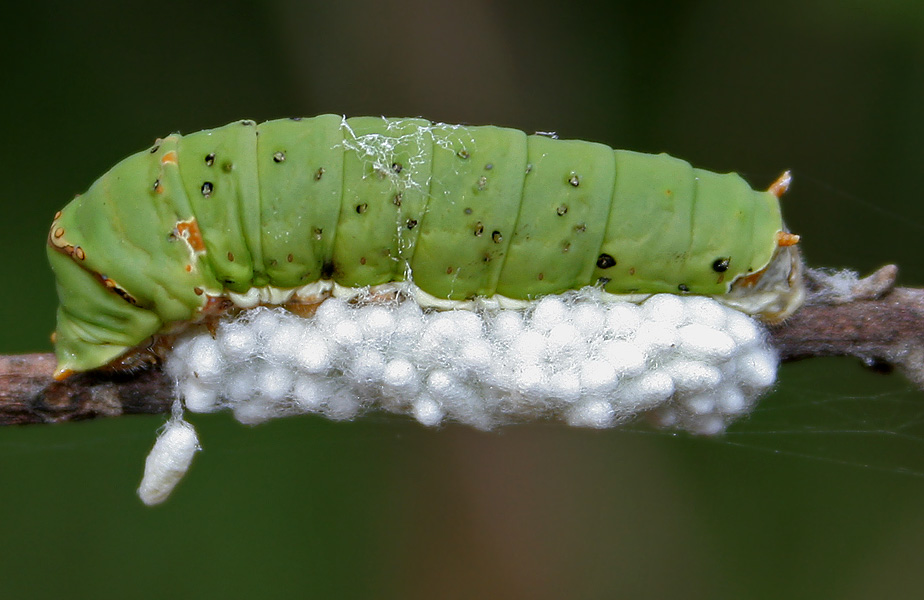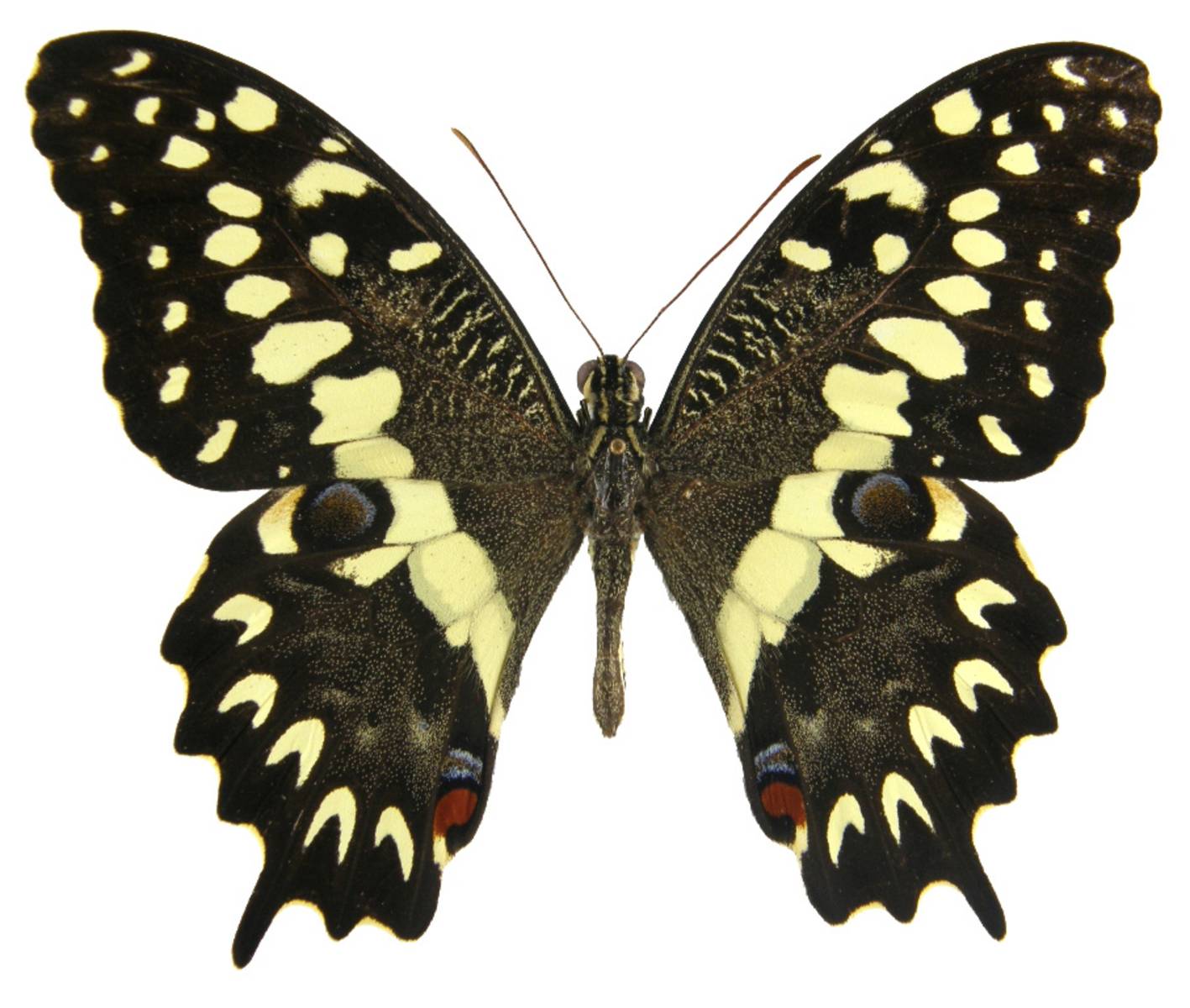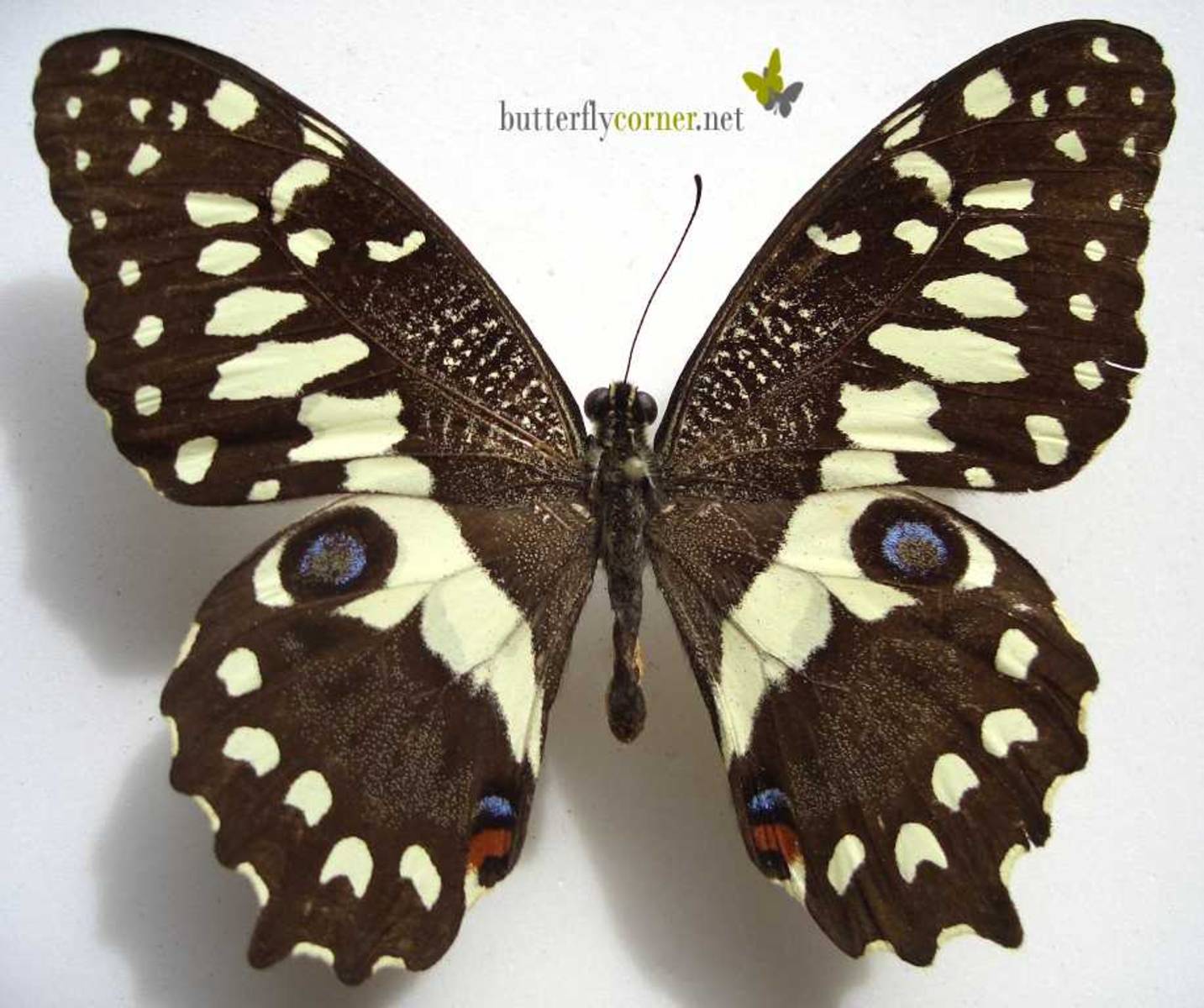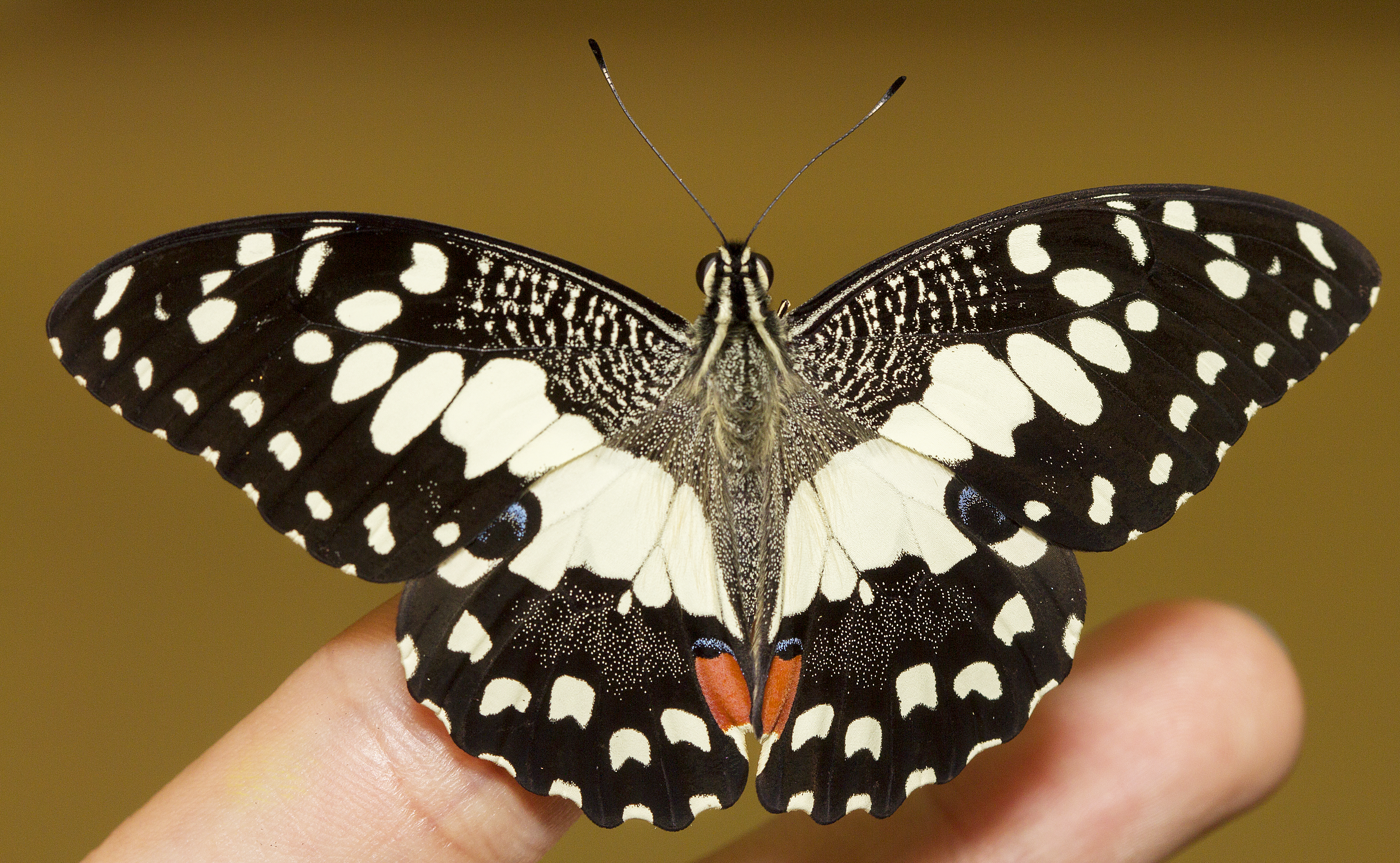 |
| Papilio demoleus butterfly spreading its wings on hand (Source: Eunice) |
| Fig.1.1 Lime butterfly resting on leave in Sunei Buloh Nature Reserve (Source: Kang Rui) |
| Fig.1.2 Male Lime butterfly resting on key lime (Source: Kang Rui) |
| Fig.1.3 Lime butterflies feeding on nectary in flight cage (Source: Kang Rui) |
Table of Contents
1.Introduction
The Lime Butterfly, Papilio demoleus is a commonly widespread swallowtail butterfly found in open areas that spans from South Asia to Australia [1]
The subspecies Papilio demoleus malayanus is found mainly in the region of Southeast Asia [2] and can usually be sighted visiting flowers n the gardens of Singapore residential areas.
The name Lime Butterfly is often derived from its foodplant that its caterpillars/larva feeds on Citrus spp. plants such as Key Lime(Citrus aurantifolia) [3] .Due to the import of kumquats (Citrus japonica) during Chinese New Year season in Singapore, you can see them more often as there are more food for their caterpillars to feed on [4] .
1.1 Etymology
“Papilio” is derived from the Latin term “papilionem” and the French term “papillon”. Both term mean “butterfly, moth”. There is no clear meaning behind the species demoleus coined by Linnaeus as the name ”demoleus” refers to a greek man who had been slain by Aeneas, a Trojan involved in the war of Troy. “Malayanus”,as the name suggested refers to the Malay peninsula where Wallace establish the subspecies as a local form in Southeast Asia[5] .
| Fig.1.4 Lime caterpillar feeding on key lime (Source: Kang Rui) |
1.2 A Pretty Pest
Although the adult lime butterfly may look pretty in our eyes, the caterpillars have a large appetite is considered as minor garden pest in Singapore. For countries with large lime plantation industry, these caterpillars can pose a serious threat in the Old World such as India and Saudi Arabia [6] . They are aggressive pests and spread across foreign countries very quickly. [7] Recent findings have shown that this species has spread to the New World such as Dominican Republic [8] and Puerto Rico [9] , threatening the livelihood of farmers that depends on lime cultivation. Therefore the lime butterflies pose as a serious threat to these countries <ref> Guerrero, K. A., Veloz, D., Boyce, S.L., Farrell, B.D. . (2004). First New World documentation of an Old World citrus pest , the Lime Swallowtail Papilio demoleus(Lepidoptera:Papilionidae), in the Dominican Republic (Hispaniola). American Entomologist, 50(4), 227-229. </ref> [10]In this species page, we will try to understand more about the biology of Papilio demoleus in order to show the impact lime butterflies have on humans as an invasive species and an economic pest. Taxonomic information will be provided the help in identification of the butterfly through its description, diagnosis and distribution throughout the world. Lastly, systematic information about the species and its related outgroups will be provided show the comparison between Papilio demoleus and other similar looking species, of which, some are rare and can only be found in Madagascar [11] . Difficult term definitions can be found in the hyperlink for your convenience
Think you spotted the lime butterfly ? . Check out our diagnosis to see if you are correct!
2. Life cycle and behavior
<picture of the life cycle>As all butterflies go through holometabolous development or complete metamorphosis, that is there are 4 stages in the life cycle of the lime butterfly. However it is difficult to distinguish lime butterfly from other species when it is larvae or pupa stage.
In Singapore, the larval and pupa stages of lime butterfly often resemble that of Common Mormon (Papilio polytes) and Great Mormon (Papilio memnon). Therefore upon spotting of these caterpillars, we can guess they belong to these 3 species. The following description of the life cycle is based on the book “Caterpillars of Singapore’s Butterflies” by Horace Tan and Khew Sin Khoon [12] .
2.1 Egg stage
| Fig.2.2 Front view of lime butterfly egg on young leaf (Source: Eunice & Kang Rui) |
Description
Eggs are laid singly on young leaves or on the underside of the leaves as well as the surface of twigs on lime host plant [13] . The eggs laid are spherical and smooth edged. Due to the tropical climate of Singapore, the time for embryo development is very short, about 2-3 days[14] .2.2Larval stage
Description
| Fig. 2.5 Side view of 3rd instar caterpillar (Source:: Eunice & Kang Rui) |
The white markings in the following 3rd instar specimen (meaning it has shed its skin 2 times) is V-shaped that covered the top and the side of its body. A row of spines can also be observed on the top side of the body. As the caterpillar grows, the size of the white marking will extend and the color will shift from light brown to dark brown or black.[15] Refer to this link for more details
| Fig. 2.6 Top view of 5th (final) instar lime caterpillar (Source: Eunice & Kang Rui) |
| Fig. 2.7 close up view of 5th (final) instar caterpillar (Source: Eunice & Kang Rui) |
| Fig. 2.8 Side view o 5th (final instar) caterpillar (Source: Eunice & Kang Rui) |
Feeding behavior
Video 1: Lime catepillar feedin behaviour (Source: Youtube, Video by Kang Rui)
Based on personal observations, the caterpillar is not active during most of the days. Instead, it simply lay motionless on the host plants throughout or simply “hiding in plain sight”. Upon feeding, it will move to the edge of the leave and search for the leave edge. The prolegs will grasp onto the the leaf and chew from the edge onwards with the help of it 3 pairs of thoracic legs.
2.3 Pupal stage
| Fig. 2. Dorsal view of Lime pupae (Source: Eunice & Kang Rui) |
| Fig.2.10 Side view of lime pupae (Source: Eunice & Kang Rui) |
| Fig.2.11 Front view of the lime pupae (Source: Eunice & Kang Rui) |
Description
The pupae take the colour of either green or brown depending on the surface that it pupate on. Pupating on non-woody or smooth surface usually results in a green pupae while pupating on woody or brown surface gives a brown pupae. [17] . The pupa is supported by the silk girdle across the thorax and attachment on cremaster.Pupation
When the caterpillar is ready to pupate, it will orientate itself to the wall with its head facing upwards and expelling its or waste from its system. A network of __silk pad__ will be spun onto the surface and attach its body to the silk girdle for extra support. Then the body of the caterpillar will shorten in length gradually forming a hunch. After a day, the body will harden into a chrysalis (unlike moth that usually spin a cocoon), forming a harden pupa with a pair of __anterior horns__ and bent away from the support.2.4 Adult stage
Description
(see the description and diagnosis section)Eclosion
Video 2: Ecolsion of lime butterfly (Source: Youtube, Video by Kang Rui)
| Fig 2.12 shell of the chysalis after eclosion (Source Eunice & Kang Rui) |
Feeding behaviour
Video 3: Locomotion and feeding behaviour of the adult lime butterfly (Source: Youtube, Video by Kang Rui)
Based on personal observation, the butterfly will come to visit the flower at 8-9am in the morning. The latest time a lime butterfly was sighted was at 4pm. Compared to other butterflies in the garden, the lime butterfly fast very fast and actively particularly in the late morning and early afternoon where the temperature is the hottest inthe day. It will dart quickly along the bushes of the flowers and feed on the nectar of any nectar plants such as Ixora spp and Bougainvillea spp. There is no special preference of flower it feeds on.
3. Adaptations
So how does it survive so well out in the wild and urban environment? The lime butterfly is packed with many forms of defense and adaptations to avoid and fend off their prey.3.1 Defense
Body camouflage
As mentioned in the life cycle, the caterpillars of the lime butterfly resemble 2 things: bird droppings (1st – 4th instar) and green leaves like its host plant (5th instar). Its camouflage will trick potential predator into ignoring them as inanimate objects or hard to seeFig.3.1 The colouration of the catepillar body resemble inanimate object such as bird's dropping or lime leaf
False eyespot
Eyespots can be found on both the adult butterfly and as well as on the caterpillar in its 5th instar. It can serve as a form of mimicry whereby the eyespot will look the the eyes of another animals, tricking potential predators by drawing their attention away or appear as an dangerous animal.[18]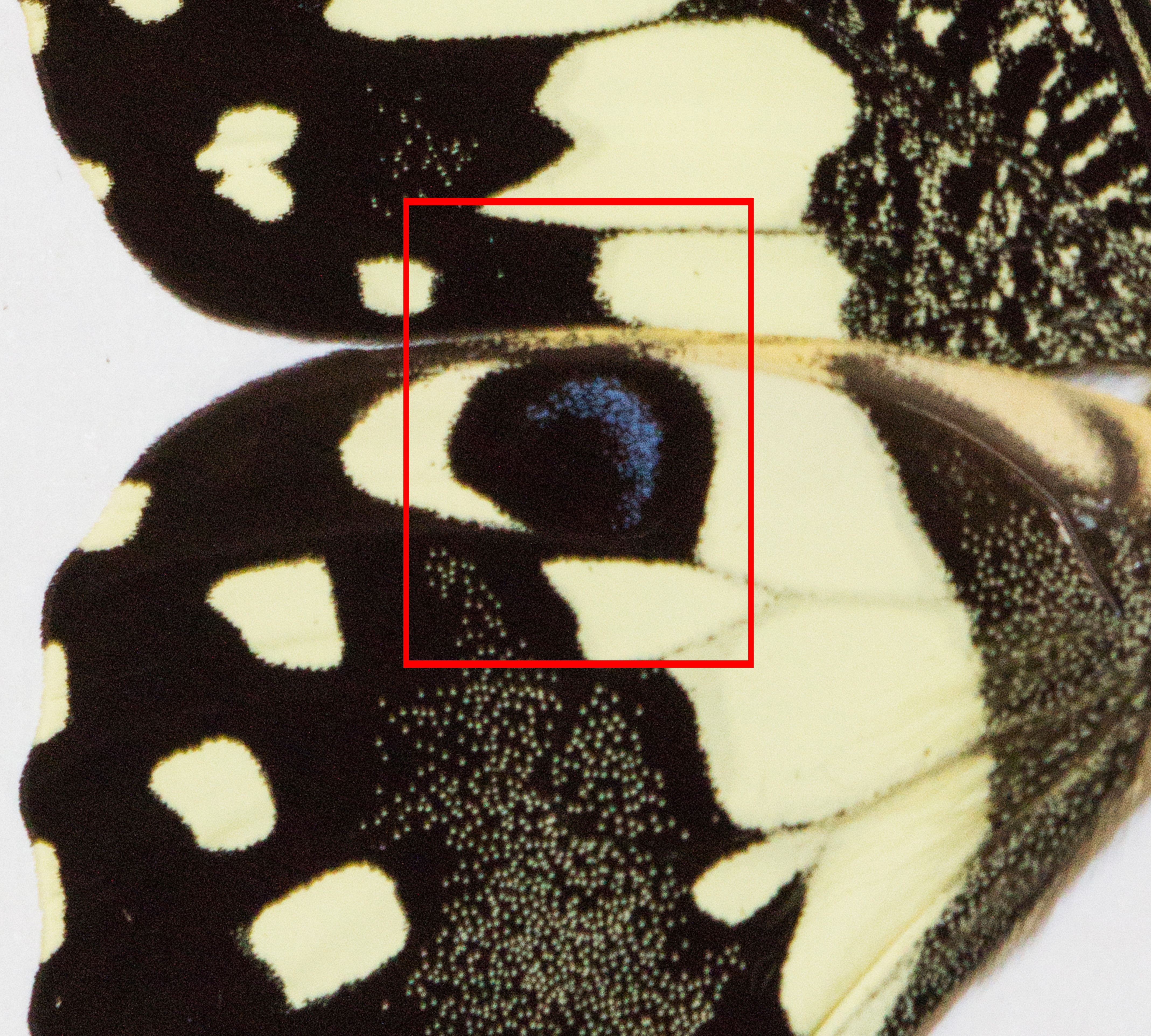
Fig. 3.2 False eyespots of the lime caterpillar (left) and adult lime butterfly wing (right) (Source: Eunice & Kang Rui)
Osmeterium – a smelly weapon
Video 4: Eversion of osmeterium as defense by lime caterpillar (Source: Youtube, Video by Kang Rui)
Osmeterium is a defensive gland that produces a pungent smell to ward off predators. When threatened, it will protrude its osmeterium from between the head and prothorax for a short period of time. The form of defense is present in all instars of the lime butterfly caterpillar include other Papilio spp. (Swallowtails). The strong odor comprises a mixture of volatile organic acids (isobutyric acid and 2-methylbutyric acid) as pheromones. [19]
Large appetite
The caterpillar have large appetites and is recorded that they can eating up 83% of the leaves on young grove trees in Andra Pradesh, India.[20]So how does it find the correct leaves to feed on? According to Khattar (1978), the caterpillar find its food by detecting the green colour as well as the odour of the Citrus spp. host plant called Citral. [21]
4. General Anatomy
4.1 Adult wing anatomy
Identification of butterfly species is heavily based on morphology and in particular the wing anatomy. The venation pattern is based on Comstock-Needham system where the venation categories are based on insect instead of Lepidoptera i.e butterflies and moths (Venation of the wings, starting from the anterior are as follows [22] :-- Subcosta (Sc),
- Radius (R1 - R5),
- Medius (M1- M3),
- Cubitus (Cu),
- Anal veins (1A,2A)
| Fig.4.1 Wing anatomy of lime butterfly. Dorsal view is found on the right side. Ventral view is found on the left side (Source: Eunice & Kang Rui) |
4.2 Adult body anatomy
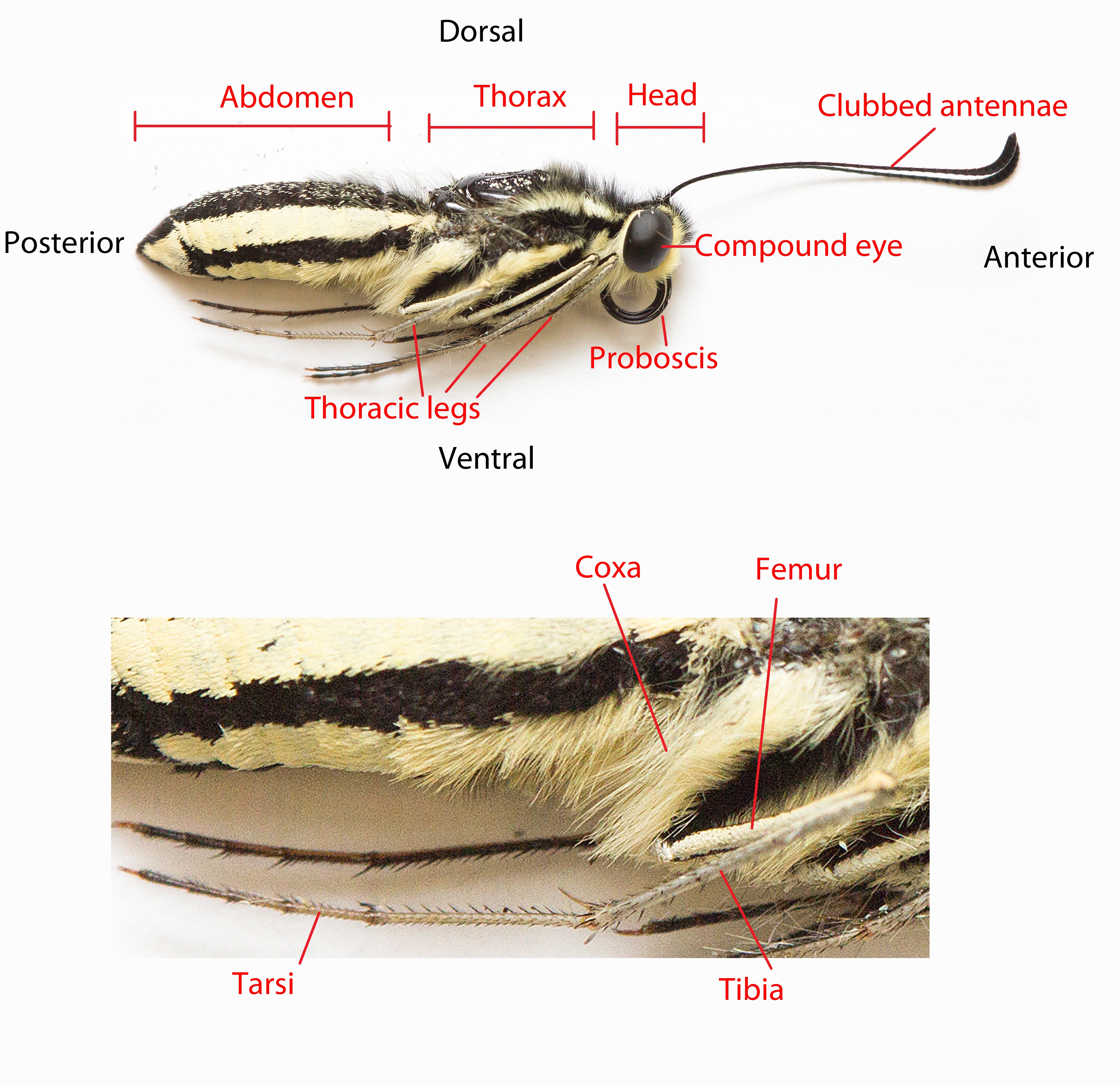 |
| Fig. 4.2 Side view of Papilio demoleus malayanus without wings. Closeup view of thoracic leg. (Photo by Eunice Soh) |
4.3 Larva anatomy
| Fig. 4.3 Side view of 5th instar lime caterpillar anatomy (Source: Eunice & Kang Rui) |
| Fig.4.4 Close up view of 5th instar caterpillar (Source Eunice & Kang Rui) |
| Fig.4.5 display of osmeterium by lime caterpillar (Source: Kang Rui) |
4.4 Pupa anatomy
==| Fig. 4.7 Dorsal view of lime pupa that is going to eclose ( Source : Kang Rui) |
5 General Description
So what does the lime butterfly Papilio demoleus look like?Butterflies are generally classified based on their wing patterns which are distinct between species. The description pertains to the species Papilio demoleus. Description of the subspecies can be found in the diagnosis section. Butterflycircle.com also provides concise information about Papilio demoleus malayanus in Singapore. The current description is based on Bascombe(1999), Braby (2000) and Corbet (1992). [23] [24]
5.1Dorsal (Upper side) Wing
| Fig.5.1 Dorsal view of lime butterfly wings a) Dorsal side of wings are brownish-black in color with a chain of irregular light yellow spots along the discal (red),submarginal (green) and marginal (blue) regions b) Hindwings has a black costal eyespot near apex that gradually spreads over the blue scales shaped as a crescent. c) In space 1b on the dorsal hind wing, there is a red tornal spot for both sexes. Different genders usually have distinctly dissimilar color composition. (Source: Eunice & Kang Rui) |
b) Hindwings has a black __costal__ eyespot near __apex__ that gradually spreads over the blue scales shaped as a crescent.
c) In __space 1b__ on the dorsal hind wing, there is a red __tornal__ spot for both sexes. Different genders usually have distinctly dissimilar color composition. See Differentiation of gender
5.2 Ventral(Underside) Wing
| Fig.5.2 Ventral view of lime butterfly wings a) Ventral side of wings are brownish-black (forewing) / yellow (hindwing) in color with a chain of irregular light yellow spots along the discal (red), submarginal (green) and marginal (blue) regions b) A series of dull-yellow spots are located on the sub apical (below the apex) of the fore wing c) Underside of hindwings has a series of elongated central (post-discal) orange spots edged with iridescent blue and black. d) Costal spot near apex is orange edged with blue and black. (Source Eunice & Kang Rui) |
b) A series of dull-yellow spots are located on the __sub apical__ (below the apex) of the fore wing
c) Underside of hindwings has a series of elongated central (post-discal) orange spots edged with iridescent blue and black.
d) Costal spot near apex is orange edged with blue and black.
5.3 Sexual dimorphism
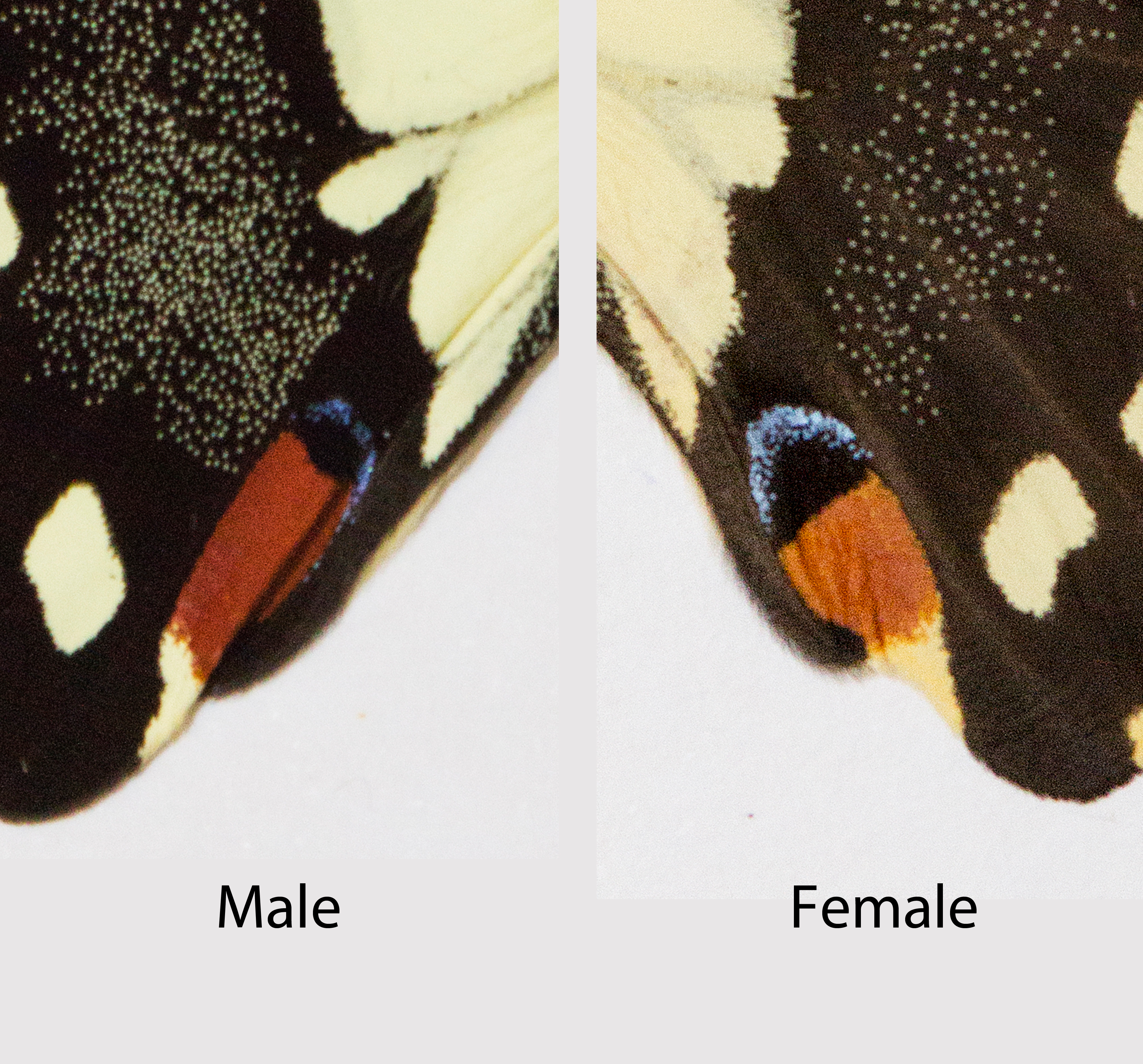 |
| Fig.5.3 Comparison of male and female lime butterfly tornal eyespot (Source: Eunice & Kang Rui) |
Males – tornal spot on upper side hind wing is mostly orange with little blue scale
Females - tornal spot on upper side hind wing is partially orange with more blue scales [25]
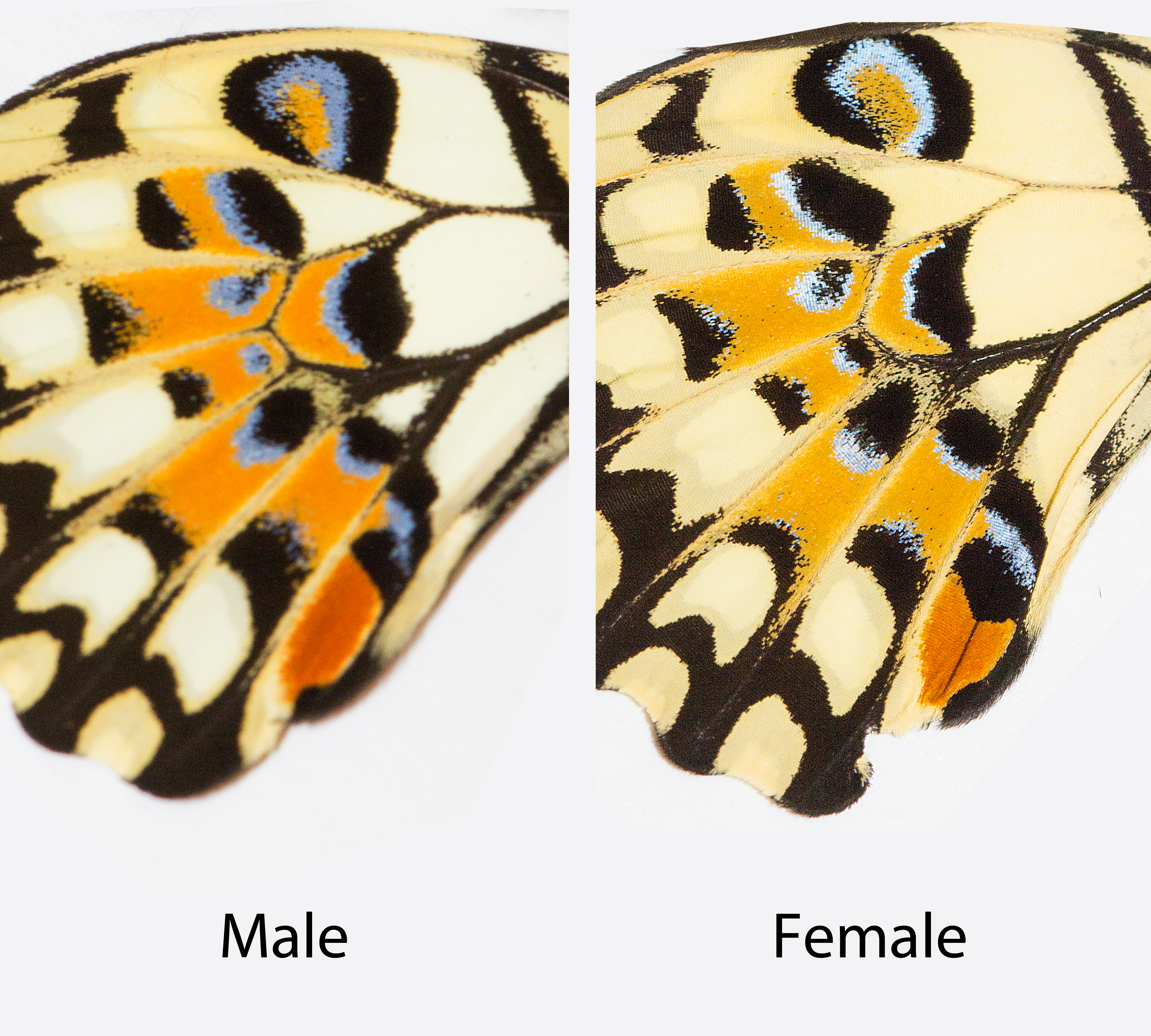 |
| Fig.5.4 Comparison of ventral hindwing of male and female lime butterfly (Source Eunice & Kang Rui) |
Males – underside of hind wing are light yellow in the discal and submarginal region
Females – underside of hind wing is dull yellow in the discal and submarginal region
In many specimens the light yellow spots are darken to dull yellow with age [26]
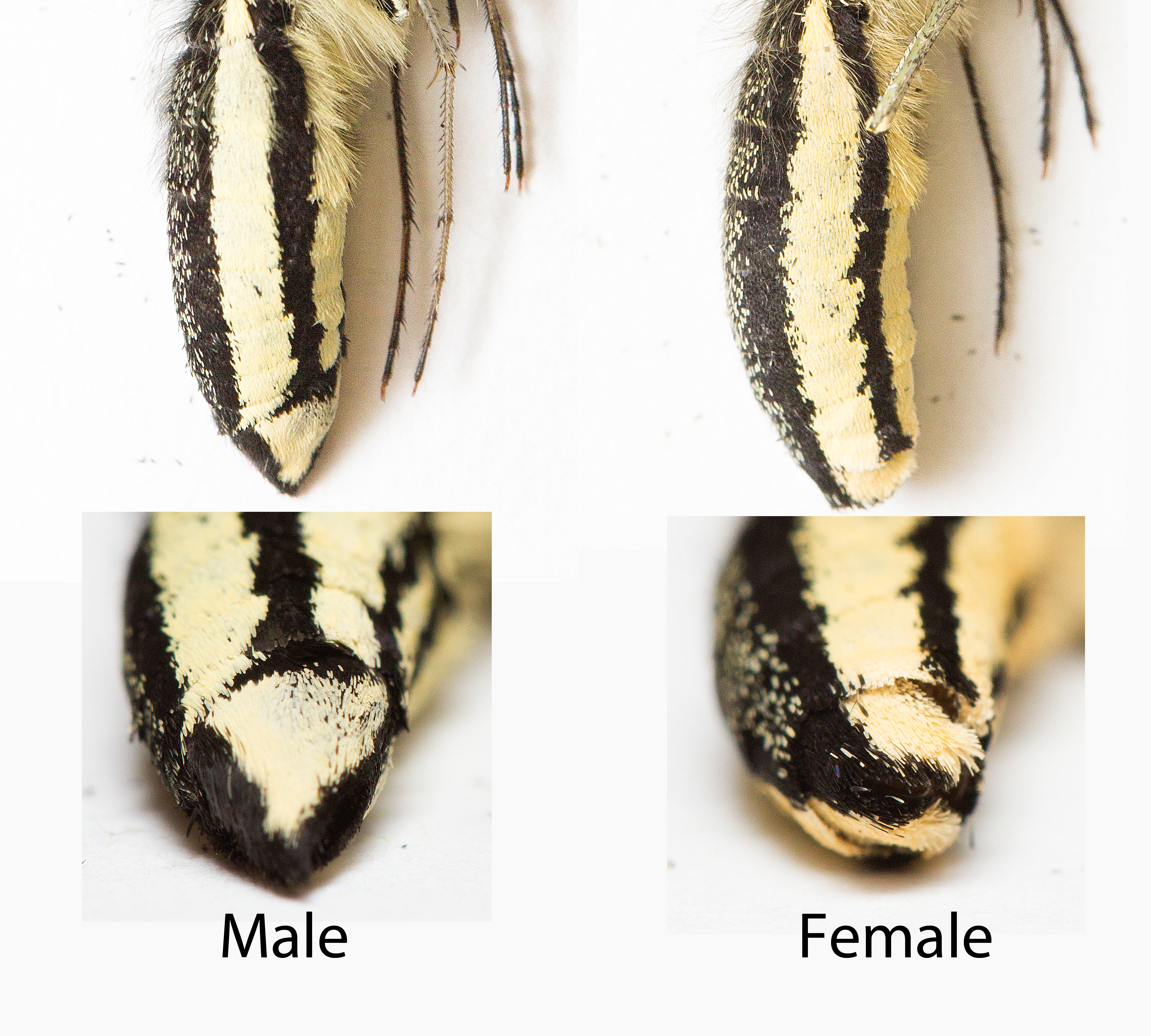 |
| Fig.5.5 Comparison of terminal abdominal segment of male and female lime butterfly (Source: Eunice & Kang Rui) |
Male – sharper abdomen shape
Female – round abdomen shape
Gender differentiation is most reliably determined by the presence of claspers , part of the male genitalia [27] .
6. Diagnosis
6.1 Papilio demoleus group (Lime Swallowtails)
The name lime swallowtail is shared by 5 different species and is often confused with Papilio demoleus . Some of which arePapilio demoleus group comprises the following 5 species that are considered lime swallowtails and has the same wing pattern of each other [28] 1[29] See Appendix for visual photo
1) Papilio demoleus Linnaeus,1758
2) Papilio morondavana Grose Smith, 1891
3) Papilio grosesmithi Rothschild,1926
4) Papilio demodocus Esper,1799
5) Papilio erithonioides Grose Smith, 1891
6.2 Differentiation of Papilio demoleus from other Lime Swallowtails
Based on the dichotomous keys provided by Smith & Vane-Wright(2008).There are 2 essential character states that differentiate Papilio demoleus from other lime swallowtails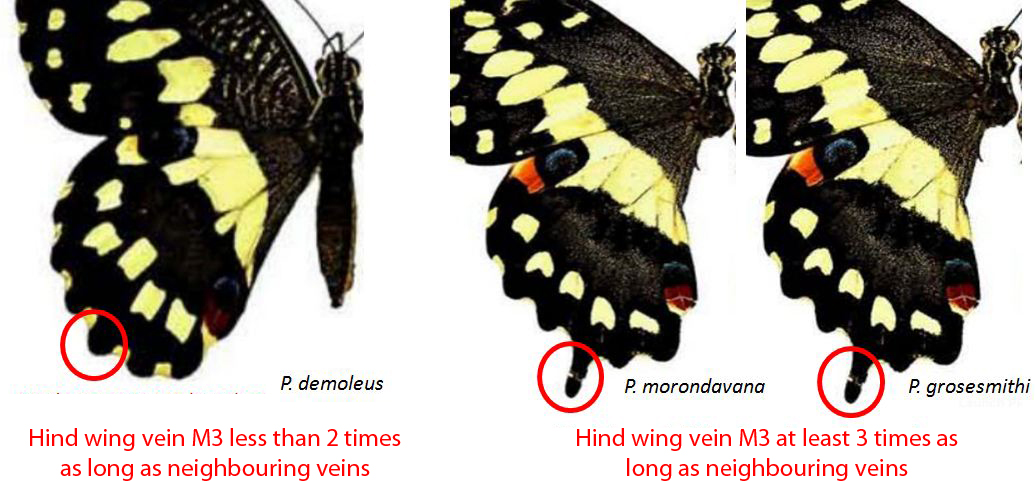 |
| Fig 6.1 Comparison of left dorsal hindwing of P.demoleus against P.morondavana and P.grosesmithi. Photo by Smith & Vane-Wright (2008) Permission not obtained but within the limits of Fair Use |
P. demoleus – tail on hindwing vein M3 is rudimentary or very short, less than twice as long as those of neighbouring veins
P.morondavana, P.grosesmithi – hind wing vein M3 extended to form distinct tail at least 3 times as long as extensions of neighbouring veins
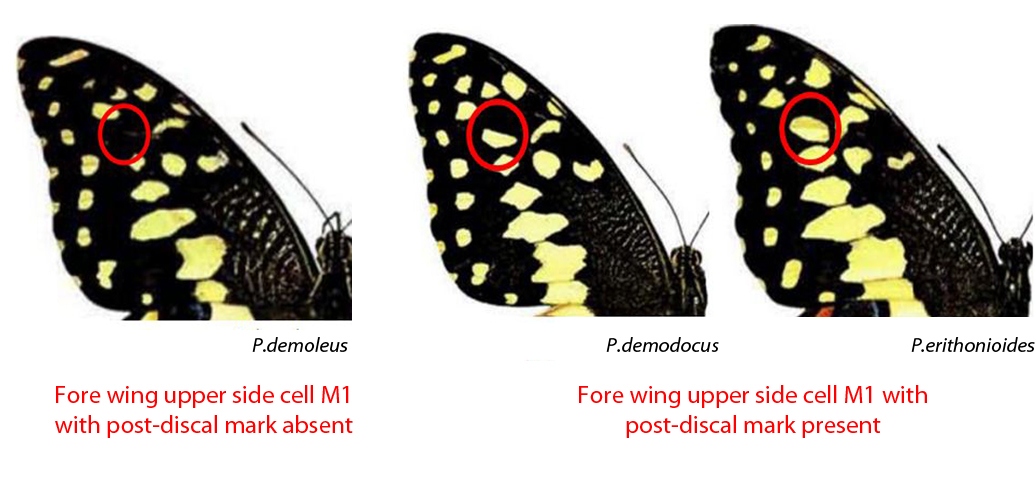 |
| Fig.6.2 Comparison of dorsal forewing of P.demoleus against P.demodocus and P.erithonioides (Photo by Smith & Vane-Wright (2008) Permission not obtained but within the limits of Fair Use) |
P.demoleus - forewing upperside cell M1 with post-discal mark absent
P.erithonioides & P.demodocus – forewing upperside cell M1 with post-discal mark present
c) External genitalia
| Fig.6.3 Genitalia of papilio demoleus (Photo by Smith & Vane-Wright (2008) Permission not obtained but within the limits of Fair Use) |
d) Locality
Papilio demoleus - South Asia , East Asia, South-east Asia, Australia and Arabian Penninsular (Green)
Papilio demodocus – Africa and Arabian Peninsular (Red)
Papilio morondavana- Madagascar (Yellow)
Papilio grosesmithi- Madagascar (Yellow)
Papilio erithonioides- Madagascar (Yellow)
Map 1: Distribution of Lime Swallowtails throughout the World (Yellow: morondavana, grosesmithi, erithonioides, Red: demodocus, Green: demoleus) (Source : Google Maps, Created by Kang Rui)
7. Distribution
7.1 Distribution in the World (Papilio demoleus)
Papiio demoleus is distributed across the world stretching from South asia to East Asia. The species then spread down south all the way to Australia. The three most common subspecies are:-- Papilio demoleus demoleus, Linnaeus 1758 which dominate the Arabian peninsular, South Asia and East Asia
- Papilio demoleus malayanus Wallace, 1865 which dominate the Southeast Asian region and the Malay Archipelago
- Papilio sthenelus, Macleay, 1826 which dominate the Australian continent.
Map 2: Distribution of Papilio demoleus subspecies throughout the World (Red : P.d.demoleus, Blue: P.d. malayanus, Green: P.d.sthenelus)
Papilio demoleus malayanus however have recently been introduced into the New World as specimens collected from Jamaica [30] .Dominican Republic [31] Puerto Rico [32] appear to resemble the subspecies. Methods of introduction are unknown according the articles
7.2 Distribution in Singapore
Generally, the subspecies Papilio demoleus malayanus can be found in most open spaces of urban Singapore. The planting of nectar flowers around residential estate help to attract these butterflies to the areas. In old estates such as Hougang areas, many residents would plant lime such as Key lime (Citrus aurantifolia) at their backyard, providing favourable host plants for the larvae of lime butterflies to feed on [33] . The following map shows some of my personal recording in collecting lime butterfly specimens.Map 3: Locations of Lime butterfly spotted in Singapore
8. Taxonomy
8.1 Name
Binomial:Species name
Papilio demoleus Linnaeus 1758
Synonyms
Princeps demoleus Linnaeus 1758
Papilio erithonius Cramer,1779
Papilio epius Fabricius,1793
Papilio demoleinus Oberthur,1879
Common names
Common Lime Butterfly
Lemon Butterfly
Lime Swallowtail
Chequered Swallow tail
Citrus Swallowtail
8.2Taxonavigation
AnimaliaArthropoda
Insecta
Lepidoptera
Ditrysia
Papilionoidea
Papilionidae
Papilioninae
Papilionini
Papilio
demoleus
8.3 Other lime swallowtails (Papilio demoleus group)
[34]1) Papilio demoleus Linnaeus,1758
2) //Papilio morondavana// Grose Smith, 1891
3) //Papilio grosesmithi// Rothschild,1926
4) Papilio demodocus Esper,1799
5) Papilio erithonioides Grose Smith, 1891a
8.4 Papilio demoleus subspecies
[35]
1) P.d .malayanus Wallace, 1865
2) P.d .demoleus Linnaeus, 1758
3) P. d. sthenelus, Macleay, 1826
4) P.d. stenelinus Rothschild, 1895
5) P.d. novoguineensis Rothschild,1908
6) P.d .libanius Fruhstorfer , 1908 (= P.d.demoleus Linnaeus, 1758)
8.5 Types series
The holotype of the Papilio demoleus is found in Royal Belgian Institute of Natural Sciences Collection holotype catalogue no. : 3120559. Systematics
Cladistic analysis done by Zakharov et al. (2004a) involves the molecular phylogeny and morphological characteristic to test for phylogenic relationship between the species in the P.demoleus group and outgroups of the Papilio genus. [38] Based on the cladogram derived from the combined data (COI, COII, Wg, EF1a genes and morphology), here is a strong support between the species in the P.demoleus group, showing that P.demoleus group is monophyletic.
Shift of basal position from P.demoleus or P.demodocus to P.morondavana.
The strongest evidence indicates that a clear sister relationship between P.demodocus and P.erithonioides is establish with P.demoleus likely to be their sister taxon. P.grosesmithi is the sister taxon of the 3 species and P.morondavana takes the basal position. The data no longer support that P.demodocus or P.demoleus is the most basal species. Therefore the finding suggest that we should consider conservation projects on P.morondava as it holds the oldest lineages in the group. Despite sharing many similarities with the pest P.demoleus, P.morondavana is endemic and should be protected for preservation of the group’s lineage.[39]
10.Human Impacts
10.1 P.demoleus as a global pest.
With a large dispersal range, high reproductive range and wide range of larval host plants, the spreading of P.demoleus population are often fast and rampant. Based from Atluri et al. (2002), the P.demoleus is capable of reproducing up to six generation annually in India [40] and has a preference for 19 species of citrus varieties including cultivated species[41] . There is also a positive correlation of P.demoleus abundance with seasonal increase in temperature and relative humidity in West Bengal, India. Originally located in the Old World, a recent record of P.demoleus species which is likely to be the subspecies from Southeast Asia or P.d.malayanus was found in Dominican Republic in 2004[42] , followed by Puerto Rico in 2006 [43]Beginning in the 1970s, invasion of P.demoleus have already occurred in the islands of Java, Borneo, Philippines and Sumatra. The invasion was facilitated by deforestation and the increase availability of citrus grove [44] [45] . P.demoleus is also known to plague citrus cultivation in Saudi Arabia and Iran. [46] .[47] has also reported that up to 83% defoliation of young grove tress in Andra Pradesh, making P.demoleus an economic pest in India as well.
The recent invasion of P.demoleus happened to have occurred by a single introduction in 2004 in Dominican Republic as evidence showed that there is a lack of genetic variation among the specimens sampled in Dominican Republic [48] . It is however not known how the species reached the Dominican Republic. Homziak & Homziak (2006) suggested that the invasion of P.demoleus in Puerto Rico in March 2006 is likely originated from the Dominican Republic [49] .
With the presence of favorable climatic conditions, favorable host plant and potential lack of predators, the establishment of P.demoleus in Dominican Republic is inevitable [50]
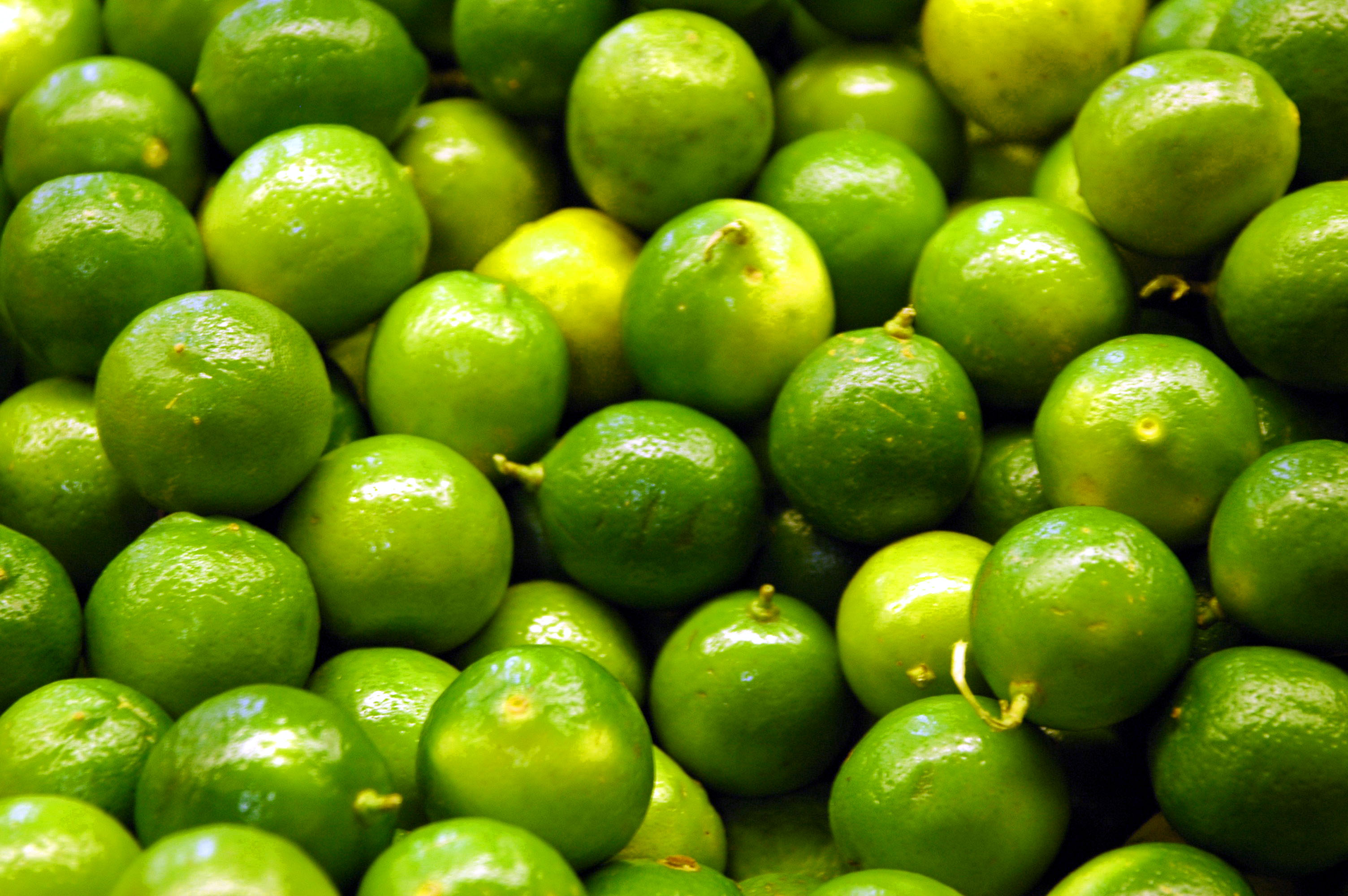 |
| Lime in US Grocery Stores (Photo from Wikicommons) |
10.2 Economic Importance
The invasion of P.demoleus into the New World such as Dominican Republic and Puerto Rico has raised alarm with regards to the potential threat this species may have on the agricultural industry of United States and Hispaniola. Based on estimates from the Caribbean cooperative citrus association (CARICOM), the production of Citrus products amounts to an approximate 1,100,000 in CARICOM countries such as Cuba, Dominican Republic and Haiti, generating an amount of US$61 million annually (Homziak & Homziak,2006) Furthermore, small citrus farms make up between 93 and 98 percent of all CARICOM farms. [51] Therefore the industry is critical to the economic survival of many small farmers [52] .Based on National Agricultural Statistic Service (2004), the value of Florida citrus crop exceed, US 1.5 billion dollars and United States total worth was more than US$2.6 billion dollar <ref> National Agricultural Statistical Service (2004). USDA Citrus Fruits Final Estimates, 1997–2002. United States Department of Agriculture Statistical Bulletins, 997(4), 1-30.</ref> . With the population of P.demoleus established in Dominican Republic, it is likely that the population can easily spread through the West Indies and surrounding areas, including the United States where impact on the agricultural industry could be catastrophic.[53]10.3 Pest Control
Biological control
Many literatures have proposed biological control of P.demoleus through the use of predators and natural pesticide. Biological predators that could be utilized to control the population[54] [55]- Egg parasitoids
|
|
| Neem seed (Source: from wikicommons) |
Non-biological control
Regulation of fatty acid has known to influence the growth development of insects. Methat (1970) has demonstrated that the use of fatty acids could serve to inhibit the growth of caterpillar larva. Treatment of lime leaves with oleic, linoleic and erucic acid at concentration higher than 0.25% proved to be toxic to the larva and inhibit pupation. [58]11. Conclusion
In summary, we can see that the appearance of P.demoleus , an economic pest, shared many similarities between its sister species in the Papilio demoleus group. Some of which are endemic. Thus, this species page hopes that people can identify such difference in the hopes that we eradicate the correct species instead of destroying an endemic one.Who is the true criminal.
12. Useful links.
1) Butterflycircle.com - A discussion forum pertaining to butterflies in Singapore2) Singapore butterfly checklist- Provides an easy checklist of the butterflies in Singapore
3) Life History of Lime butterfly - A blog from butterfycircle that features a great amount of detail on the life stages of the lime butterfly in Singapore
4) Samui butterflies - A aesthetically pleasing photo gallery featuring butterflies of southeast asia and of cours lime butterflies
5) Learn about butterflies - Provides a generally knowledge about butterflies in the world.
13. Appendix
Other lime swallowtailsPapilio morondavana
| Description 1) Hindwing vein M3 extended to form distinct tail at least 3 times as long as extensions of neighbouring veins. 2) Forewing upperside discal cell with basal pale scales apparently randomly scattered, not forming any noticeable pattern. 3) Forewing cells R3 – M1 with submarginal marks large and clear and sharp edged, that in R3 forming a bar across the cell 4) Hindwing upperside cells R5- M3 either shallowly concave or with slight indentation distally Locality - Madagascar |
|
|
Papilio grosesmithi
| Description 1) Hindwing vein M3 extended to form distinct tail at least 3 times as long as extensions of neighbouring veins. 2) Forewing upperside discal cell with basal pale scales aggregated into narrow transverse markings 3) Forewing cells R3-M1 with submarginal marks small and faint 4) Hindwing upperside cells R5-M3 with submarginal marks deeply indented distally, that in M3 chevron-shaped. Locality - Madagascar |
|
|
Papilio erithonioides
| 1) Tail on hindwing vein M3 rudimentary or very short, less than twice as long as those on neighbouring veins 2) Forewing upperside cell M1 with post-discal mark present 3) Basal pale marks in hindwing underside cell R1 and discal cell very broad, separated from discal marks only by a narrow dark band. Locality - Madagascar |
|
|
Papilio demodocus
| Description 1) Tail on hindwing vein M3 rudimentary or very short, less than twice as long as those on neighbouring veins 2) Forewing upperside cell M1 with post-discal mark present 3) Basal pale marks in hindwing underside discal cell and cell R3 narrow, separated from discal marks by a dark band much broader than the basal marks Locality - African continent - Arabian peninsular |
|
|
Papilo demoleus
| Description 1) Tail on hindwing vein M3 rudimentary or very short, less than twice as long as those on neighbouring veins 2) Forewing upperside cell M1 with post-discal mark absent Locality - Arabian peninsular - South Asia - East Asia - Southeast Asia - Australian continent |
|
|
Smith, C. R., Vane-Wright,R.I. (2008). Classification, nomenclature and identification of lime swallowtail butterflies: A post‐cladistic analysis (Lepidoptera: Papilionidae). Systematics and Biodiversity, 6(2), 175-203.
Smith, C. R., Vane-Wright,R.I. (2008). Classification, nomenclature and identification of lime swallowtail butterflies: A post‐cladistic analysis (Lepidoptera: Papilionidae). Systematics and Biodiversity, 6(2), 175-203.
Tan, H., Khew, S.K. (2012). Caterpillars of Singapore’s Butterflies. Singapore: National Parks Board
Smith, C. R., Vane-Wright,R.I. (2008). Classification, nomenclature and identification of lime swallowtail butterflies: A post‐cladistic analysis (Lepidoptera: Papilionidae). Systematics and Biodiversity, 6(2), 175-203.
Badawi, A. (1981). Studies on some aspects of the biology and ecology of the citrus butterfly Papilio demoleus L. in Saudi Arabia (Papilionidae: Lepidoptera). Zeitschriftfuer Angewandte Entomologie,91(3), 286-292.
Homziak, N. T., Homaziak, J. (2006). Papilio demoleus (Lepidoptera: Papilionidae): A New Record for the United States, Commonwealth of Puerto Rico. Florida Entomologist, 89(4), 485-488.
Smith, C. R., Vane-Wright,R.I. (2008). Classification, nomenclature and identification of lime swallowtail butterflies: A post‐cladistic analysis (Lepidoptera: Papilionidae). Systematics and Biodiversity, 6(2), 175-203.
Tan, H., Khew, S.K. (2012). Caterpillars of Singapore’s Butterflies. Singapore: National Parks Board
Alturi, J. B., Ramana, S.P.V., Reddi., C.S. (2002)Life history of Princeps demoleus (Lepidoptera: Rhopalocera: Papilionidae) from India. Journal of National Taiwan Museum, 55, 27–32.
Tan, H. (2011). Life history of lime butterfly v2.0. Butterflycirle. Retrieved 10 November, 2013, from http://butterflycircle.blogspot.sg/2011/11/life-history-of-lime-butterfly-v20.html
Alturi, J. B., Ramana, S.P.V., Reddi., C.S. (2002)Life history of Princeps demoleus (Lepidoptera: Rhopalocera: Papilionidae) from India. Journal of National Taiwan Museum, 55, 27–32.
Smith, A.G. (1978). Environmental Factors Influencing Pupal Colour Determination in Lepidoptera. I. Experiments with Papilio polytes, Papilio demoleus and Papilio polyxenes" (abstract). Proceedings of the Royal Society of London. Series B, Biological Sciences 200 (1140): 295–329
Stevens, M. (2005). The role of eyespots as anti-predator mechanisms, principally demonstrated in the Lepidoptera. Biological Reviews, 80(4), 573-588.
Chow, Y. S., Tsai, R.S. (1989). Protective chemical in caterpillar survival. Experientia (Basel), 45(4), 390-392.
Thakare, K. R., Borle,M.N. (1974). Outbreak of lemon butterfly in Maharashtra India. Punjabrao Krishii Vidyapeeth Research Journal, 2, 82-85.
Khattar, P., Saxena, K.N (1978). Interaction of Visual and Olfactory Stimuli Determining Orientation of Papilio demoleus Larvae. Journal of Insect Physiology, 24, 571-576.
Miller, L. D. (1969). Nomenclature of Wing Veins and Cells Journal of Research on the Lepidoptera, 8(2), 37-48.
Bascombe, M. J., Johnston,G., Bascombe,F.S. (1999). The Butterflies of Hong Kong Lomdon: Academic Press. <ref> Braby, M. F. (2000). The butterflies of Australia: their identification, biology and distribution (Vol. 1). Australia: CSIRO Publishing
Braby, M. F. (2000). The butterflies of Australia: their identification, biology and distribution (Vol. 1). Australia: CSIRO Publishing
Bascombe, M. J., Johnston,G., Bascombe,F.S. (1999). The Butterflies of Hong Kong London: Academic Press.
Bascombe, M. J., Johnston,G., Bascombe,F.S. (1999). The Butterflies of Hong Kong London: Academic Press.
Zakharov, E. S., C.; Lees, D.C.; Cameron, A.; Vane-Wright,R.I.; Sperling, A.H. (2004a). Independent gene phylogenies and morphology demonstrate a Malagasy origin for a wide-ranging group of swallowtail butterflies Evolution, 58(12), 2763-2782.
NAPPO. (2006). Lime Swallowtail (Papilio demoleus) detected in the municipality of Guanica, Puerto Rico.
Tan, H., Khew, S.K. (2012). Caterpillars of Singapore’s Butterflies. Singapore: National Parks Board.
Smith, C. R., Vane-Wright,R.I. (2008). Classification, nomenclature and identification of lime swallowtail butterflies: A post‐cladistic analysis (Lepidoptera: Papilionidae). Systematics and Biodiversity, 6(2), 175-203.
Smith, C. R., Vane-Wright,R.I. (2008). Classification, nomenclature and identification of lime swallowtail butterflies: A post‐cladistic analysis (Lepidoptera: Papilionidae). Systematics and Biodiversity, 6(2), 175-203.
Honey, M. R., Scoble, M.J. (2001). Linnaeus's butterflies(Lepidoptera: Papilionoidea and Hesperioidea). Zoological Journal of the Linnean Society, 132, 277-399.
Smith, C. R., Vane-Wright,R.I. (2008). Classification, nomenclature and identification of lime swallowtail butterflies: A post‐cladistic analysis (Lepidoptera: Papilionidae). Systematics and Biodiversity, 6(2), 175-203.
Zakharov, E. S., C.; Lees, D.C.; Cameron, A.; Vane-Wright,R.I.; Sperling, A.H. (2004a). Independent gene phylogenies and morphology demonstrate a Malagasy origin for a wide-ranging group of swallowtail butterflies Evolution, 58(12), 2763-2782.
Zakharov, E. S., C.; Lees, D.C.; Cameron, A.; Vane-Wright,R.I.; Sperling, A.H. (2004a). Independent gene phylogenies and morphology demonstrate a Malagasy origin for a wide-ranging group of swallowtail butterflies Evolution, 58(12), 2763-2782.
Alturi, J. B., Ramana, S.P.V., Reddi., C.S. (2002). Life history of Princeps demoleus (Lepidoptera: Rhopalocera: Papilionidae) from India. Journal of National Taiwan Museum, 55, 27–32.
Matsumoto, K. (1996). Establishment of Papilio demoleus L. (Papilionidae) in Java. Journal of Lepidopteran Society, 50, 139-140.
Homziak, N. T., Homaziak, J. (2006). Papilio demoleus (Lepidoptera: Papilionidae): A New Record for the United States, Commonwealth of Puerto Rico. Florida Entomologist, 89(4), 485-488.
Guerrero, K. A., Veloz, D., Boyce, S.L., Farrell, B.D. . (2004). First New World documentation of an Old World citrus pest , the Lime Swallowtail Papilio demoleus(Lepidoptera:Papilionidae), in the Dominican Republic (Hispaniola). American Entomologist, 50(4), 227-229.
Homziak, N. T., Homaziak, J. (2006). Papilio demoleus (Lepidoptera: Papilionidae): A New Record for the United States, Commonwealth of Puerto Rico. Florida Entomologist, 89(4), 485-488.
Guerrero, K. A., Veloz, D., Boyce, S.L., Farrell, B.D. . (2004). First New World documentation of an Old World citrus pest , the Lime Swallowtail Papilio demoleus (Lepidoptera:Papilionidae), in the Dominican Republic (Hispaniola). American Entomologist, 50(4), 227-229.
Thakare, K. R., Borle,M.N. (1974). Outbreak of lemon butterfly in Maharashtra India. Punjabrao Krishii Vidyapeeth Research Journal, 2, 82-85.
Lewis, D. S. (2009). Lime Swallowtail, Chequered Swallowtail, Citrus Swallowtail Papilio demoleus Linnaeus (Insecta: Lepidoptera: Papilionidae, January 2009.
Pandey, S., Pandey, J.P, Tiwari,R.K. (2011). Effect of Some Neem Based Insecticides on Wing Shape and Pigmentation in Lemon-Butterfly, Papilio demoleus L. . World Applied Science Journal, 13(6), 1356-1360.
Mehta, R. C. (1970). Use of Fatty Acids for the Control of Papilio demoleus L. Naturwissenschaften, 57(11), 546.
